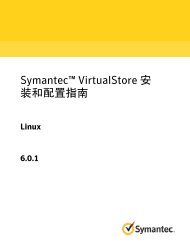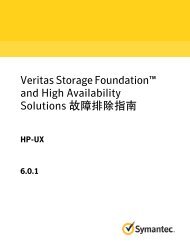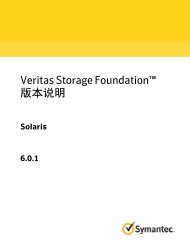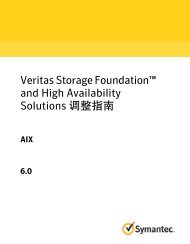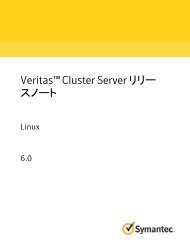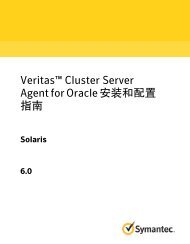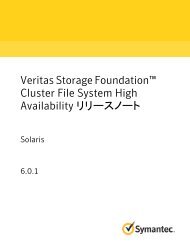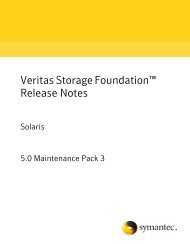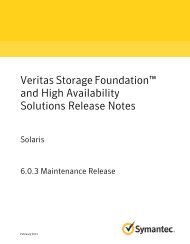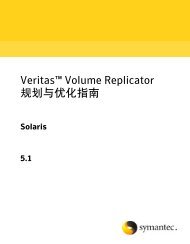Veritas Storage Foundation Release Notes
Veritas Storage Foundation⢠Release Notes: HP-UX - Symantec
Veritas Storage Foundation⢠Release Notes: HP-UX - Symantec
You also want an ePaper? Increase the reach of your titles
YUMPU automatically turns print PDFs into web optimized ePapers that Google loves.
14<br />
<strong>Storage</strong> <strong>Foundation</strong> <strong>Release</strong> <strong>Notes</strong><br />
Changes introduced in 6.0<br />
to shred the data on the disk to minimize the chance that the data is recoverable.<br />
When you specify the disk shred operation, VxVM shreds the entire disk, including<br />
any existing disk labels. After the shred operation, VxVM writes a new empty<br />
label on the disk to prevent the disk from going to the error state. The VxVM shred<br />
operation overwrites all of the addressable blocks with a digital pattern in one,<br />
three, or seven passes.<br />
Caution: All data in the volume will be lost when you shred it. Make sure that the<br />
information has been backed up onto another storage medium and verified, or<br />
that it is no longer needed.<br />
For more information on shredding disks, see the <strong>Veritas</strong> <strong>Storage</strong> <strong>Foundation</strong><br />
Administrator's Guide.<br />
Creating a volume of maximum size<br />
In previous releases, <strong>Veritas</strong> Volume Manager provided a two-step approach to<br />
creating a volume of the maximum size. You had to run the vxassist maxsize<br />
command to find the maximum size of the volume to be created with the given<br />
constraints. Then, you had to run the vxassist make command and specify the<br />
volume size as the maximum determined by the vxassist maxsize command.<br />
In this release, you can create a maximum sized volume with a single command.<br />
Specify the vxassist make command with the maxsize keyword. The vxassist<br />
command creates the maximum sized volume possible, taking into consideration<br />
any other allocation attributes that you specify.<br />
Changing VxVM tunables<br />
The vxtune command is used to display or modify the values of <strong>Veritas</strong> Volume<br />
Manager tunable parameters. In this release, the vxtune command is extended<br />
and enhanced. The vxtune command has the following new functionality:<br />
■<br />
■<br />
■<br />
manages an extended list of <strong>Veritas</strong> Volume Manager tunable parameters,<br />
including <strong>Veritas</strong> Volume Replicator and Cluster Volume Manager tunable<br />
parameters.<br />
provides a template format for tuning parameters. The template feature enables<br />
you to export the list of tunable parameters into a file, modify the values as<br />
necessary, then reload the tunables with an import command.<br />
enhanced command output. The output now displays the current value, the<br />
default value, and whether a reboot is required for the new value to take effect.<br />
Optionally, the output displays a description of the tunable parameters.



